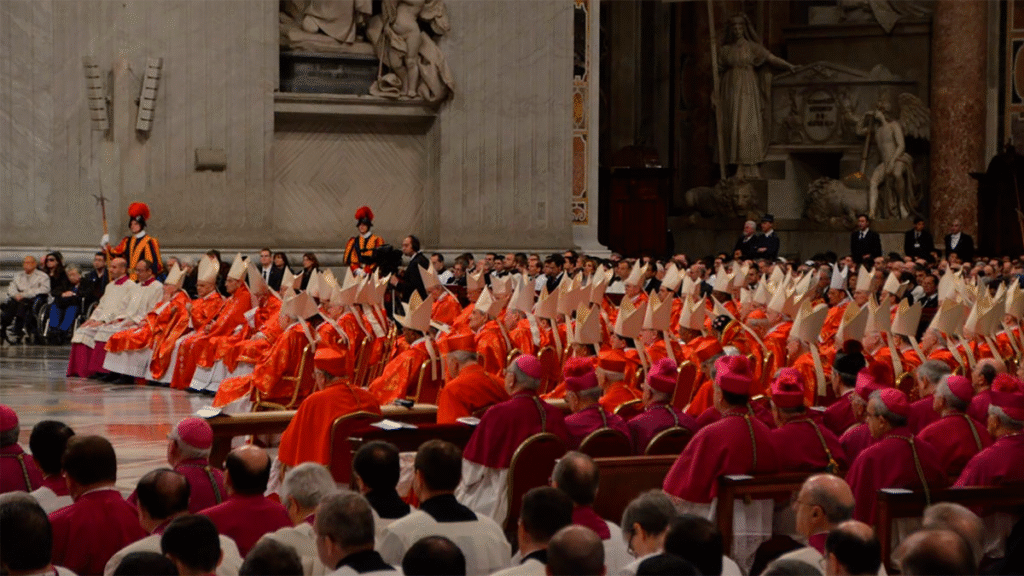The Impact of Pope Francis’s Death
Pope Francis’s death has two immediate effects. First, it halts the reforms he proposed, summarized by the term sinodality; second, it initiates a period of sede vacante, a transitional governance phase requiring the convening and organization of a conclave to select his successor.
The Duties of the Camerlengo
Cardinal Kevin Joseph Farrell, tasked with special Saint Peter’s Basilica legislation, announced Pope Francis’s death, beginning a unique role in a highly regulated process. Farrell certified the death, sealed the papal apartments to protect belongings, and destroyed the Fisherman’s Ring and lead seal, symbols of Francis’s pontificate.
Farrell became the administrator of the Church’s temporal goods and rights, ensuring governance continuity without assuming papal spiritual authority. Crucially, he organizes the conclave through a series of acts, including preparing nine-day pontifical funeral celebrations.
Sede Vacante: An Ordered Process with Supreme Precision
Upon the legitimate vacancy declaration of the Apostolic See on April 21, 2025, at 8:00 AM, the transition period began, with the conclave’s start tentatively set 15 to 20 days later, likely between May 6 and 11. The Cardinal College can advance the start if all electors are present.
Decano of the Cardinal College, Cardinal Giovanni Battista Re, must convene general assemblies for preparation, including cardinals over 80 who won’t vote. These daily meetings allow the College’s opinion to be heard and progress updates, fostering early trends.
The Successor’s Authority
The Cardinal College cannot alter, suspend, or continue processes exclusive to the deceased pope. Though it holds papal civil power related to Vatican governance, it cannot issue decrees except in urgent cases during sede vacante. Decree validity depends on the new pope’s ratification.
Secretary of State functions, prefects, and dicasterio heads cease. Cardinals and bishops in dicasterios stop their responsibilities. Few positions remain functional due to restrictions on bishop appointments and ecclesiastical structure changes. This interregnum ensures fundamental Iglesia matters remain reserved for the future pope, affecting Francis’s ongoing reforms connected to Spes non confundit, calling for the 2025 Ordinary Jubilee.
Absolute Secrecy Under Penalty of Excommunication
Cardinal activities during sede vacante and the conclave are marked by secrecy. They must refrain from external correspondence or communication until the election concludes and results are announced.
Before voting, cardinals swear an oath touching the Gospels, committing to proper intentions and absolute secrecy under excommunication latae sententiae penalty.
After the oath, the liturgical celebrations master orders non-conclave personnel to leave the Sistine Chapel. Recording, reproducing, or transmitting voices, images, or texts is prohibited in conclave locations.
Voting by Scrutiny Alone
The voting system abolished acclamation and inspiration methods, leaving only scrutinium, secret ballot. A valid election requires at least two-thirds of present cardinals’ votes. If no result emerges in the first scrutiny, two morning and two afternoon votes follow consecutively.
Once elected, the decano asks the candidate if they accept and what name they wish to take. If already an bishop, they immediately assume papal authority. Otherwise, they must be ordained as Rome’s bishop before assuming the papacy. Cardinal electors honor the new pope, who delivers the apostolic blessing urbi et orbi from Saint Peter’s Basilica balcony.
The 2025 conclave will shape the Church’s future, potentially initiating a counter-reformation against Francis’s sinodality proposal or embracing his legacy. The outcome will always be a Casta meretrix – saintly yet sinful – Church.
Key Questions and Answers
- What is the immediate impact of Pope Francis’s death? It halts his reform proposals and initiates a conclave to select his successor.
- Who is Cardinal Kevin Joseph Farrell, and what are his duties? He is the Camerlengo responsible for managing the Church’s temporal goods and rights, ensuring governance continuity, and organizing the conclave.
- What is sede vacante, and how is it managed? Sede vacante is the transitional governance phase following a pope’s death. It involves a highly ordered process, with the Cardinal College preparing for and convening general assemblies.
- What powers does the Cardinal College hold during sede vacante? The College cannot alter, suspend, or continue exclusive papal processes. It holds civil power related to Vatican governance but cannot issue decrees except in urgent cases.
- How is the conclave conducted, and what voting system is used? The conclave follows a series of acts, including preparing pontifical funerals. Voting is by scrutinium, secret ballot, requiring at least two-thirds of present cardinals’ votes.
- What is absolute secrecy during the conclave, and how is it enforced? Absolute secrecy is maintained by cardinals refraining from external communication until the election concludes. They swear an oath under penalty of excommunication, and non-conclave personnel are ordered to leave conclave locations.






